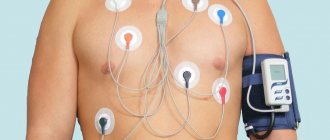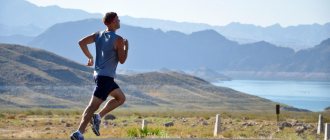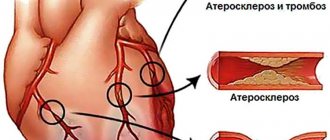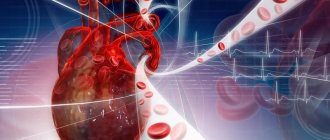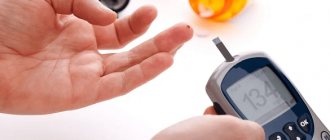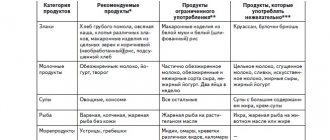Reception is conducted by:
Krivonosov Denis Sergeevich -
cardiologist, candidate of medical sciences
Make an appointment
A characteristic feature of modern society is physical inactivity - a disruption in the functioning of the body due to a lack of physical activity. The development of the transport network, automation of production and the increase in the number of “knowledge” workers have led to the fact that people began to lead a sedentary lifestyle. Unfortunately, this factor has a negative impact on the health of the human cardiovascular system. Diseases such as angina pectoris, stroke, and heart attack have become increasingly common. Therapeutic exercise for coronary artery disease is an important component of the rehabilitation of patients who have suffered heart disease.
The benefits of physical activity for cardiac ischemia
For physical rehabilitation, doctors prescribe light exercises at the very beginning of the post-infarction period. The purpose of such exercises is to restore breathing and bring the patient out of a serious condition.
It must be remembered that therapeutic exercises for ischemic heart disease are prescribed strictly by a specialist. Excessive physical activity and too intense exercise can negatively affect your health and lead to a relapse of the attack.
Regular physical activity is beneficial for everyone. For healthy people, it helps prevent the onset of diseases, and for those who have already suffered heart disease, physical education reduces the recovery period and prevents the development of relapse.
Physical activity for coronary artery disease helps:
- keep muscles toned;
- reduce the level of atherogenic lipids in the blood (cholesterol, low-density lipoprotein, etc.), thereby reducing the risk of atherosclerosis;
- normalize blood pressure;
- prevent the formation of blood clots;
- improve quality of life, improve mood;
- normalize sleep;
- prevent obesity and reduce the risk of diabetes.
According to medical research, people who engage in physical therapy after a heart attack are 7 times less likely to suffer a recurrence of such a heart attack and reduce the likelihood of death by 6 times. Exercise therapy for coronary heart disease can improve the general health of the patient. Regular exercise improves blood flow, minimizes the effects of heart failure, and strengthens the cardiovascular system.
Features of physical education for ischemic heart disease
Not all types of physical activity are suitable for patients suffering from coronary heart disease. The type of load and its intensity are determined by the attending physician based on the specific clinical picture.
For patients who have suffered heart disease, the nature of exercise therapy can be of decisive importance:
- With moderate activity, recovery speeds up, strength and endurance of the body increase.
- With excessive exercise, angina pectoris may occur, which often leads to a repeat attack.
The priority areas of physical education are exercises aimed at developing endurance. These include quiet walks, cycling, housework, and dancing. Loads should gradually increase. In this case, the heart rate should increase by no more than 15-20 beats per minute.
Contraindications for angina pectoris
The main contraindications for angina are related to preventing the development of hypertension. In this regard, it is important to avoid excessive physical activity and the use of psychostimulants (coffee, ginseng, eleutherococcus, dishes high in hot pepper and salt, and so on). The presence of angina pectoris syndrome in most cases indicates weakness of the blood vessels, and therefore it is not recommended to make sudden movements (including quickly getting out of bed when waking up, etc.). In most cases, it is not recommended to prescribe spa treatment.
Indications and contraindications
Coronary heart disease is a pathological condition that is characterized by disruptions in the blood supply to the myocardium due to damage to the coronary vessels. The reason for this situation is the lack of oxygen entering the heart with blood. Indications for performing therapeutic exercises are acute forms of coronary artery disease (with a history of myocardial infarction) and chronic forms (with periodic attacks of angina pectoris).
Contraindications for exercise therapy for ischemic heart disease:
- frequent attacks of angina pectoris;
- acute disturbances in coronary circulation;
- advanced stages of heart failure;
- persistent arrhythmia;
- cardiac aneurysm.
For patients suffering from angina, doctors recommend that they carry out therapeutic exercises in between attacks. So, with a mild attack, simple exercises can be done already on the second day, with a moderate attack - on the fourth, with a severe attack - on the eighth.
Contraindications to performing physical and breathing exercises
During an attack of angina, breathing exercises are effective and have no side effects, but there are people who cannot perform them, because for them it is contraindicated. These include:
- pregnant and lactating women;
- persons diagnosed with exacerbation of chronic pathology of any origin;
- with an inflammatory process in the small and large pelvis;
- patients with adenomyosis.
Even for people not included in this list, it would be a good idea to consult a doctor to select the right method of physical and breathing exercises. This will reduce negative risks and help achieve a positive effect.
Rules for performing physical exercises for ischemic heart disease
Physical education for patients with coronary heart disease is carried out only after the condition has been stabilized.
Initially, it is advisable to do breathing exercises and exercises aimed at the activity of individual muscle groups. Then, in a clinical setting, a submaximal test is performed to determine the permissible intensity and volume of loads as part of post-infarction rehabilitation.
The test ends when the heart rate increases to 120 beats per minute or when clear signs of intolerance appear. The heart rate recorded at the end of testing becomes the threshold value and subsequent physical activity should not exceed 75% of the experimentally established value.
At first, the optimal loads will be: therapeutic exercises, walking, exercise bike, swimming, jogging.
Prohibited loads, permitted loads - with the sign “+„. The number of “+” signs indicates the permissible intensity and volume of loads.
Recommended loads
For patients with different stages of pathology, their own exercises are prescribed so that exercise for angina only brings benefits.
At the initial stage
Patients with this pathology experience virtually no unpleasant symptoms or pain. Manifestations of the disease occur rarely and are short-lived. Therefore, it is acceptable for them to train for half an hour with dynamic and intense exercises, but without high stress on the heart. It is permissible to load all muscle groups at once in one session, this will help improve the tone of the entire internal system of the body.
On a typical
Negative symptoms of the pathology in the typical form occur precisely during physical activity. Long walking or intense training can provoke:
- shortness of breath;
- vertigo;
- arrhythmia, etc.
Stress or strong feelings also lead to similar symptoms. Therefore, such patients are prescribed physical training with less intensity. Each approach should be alternated with a break in which you need to check your heart rate and pulse. The duration of the complex should not exceed a quarter of an hour, and if the pulse exceeds the norm by 15%, then stop altogether.
On a pronounced
This is the most acute stage of angina, when discomfort is felt even at rest. For such patients, classes are possible only in a hospital setting under the supervision of a doctor.
WE RECOMMEND: First medical and first aid for acute heart failure He is prohibited from high-intensity and long-term exercise.
Gymnastics for angina pectoris, a set of exercises is performed at a calm, moderate pace. If you experience shortness of breath, dizziness, or heart pain, you need to take a break and reduce the amplitude of the exercises.
You don’t need to study for more than 10 minutes, and the break should be at least half of the total lesson time.
Daily physical activity
| Type of activity | Function class | |||
| I | II | III | IV | |
| Run | ++ | + | — | — |
| Walking: Fast (130 steps/min) Medium (100/120 steps/min) Slow (<= 80-90 steps/min) | +++ +++ +++ | ++ +++ +++ | — ++ +++ | — — — |
| Climbing stairs (floors) | 5 or more | up to 5 | 2-3 floors | — |
| Carrying heavy loads (kg) | 15-16 | 8-10 | 3 | — |
| Having sex | +++ | ++ | + | — |
Types of household work
| Type of activity | Function class | |||
| I | II | III | IV | |
| Sawing | + | — | — | — |
| Working with a hand drill: comfortable position, uncomfortable position | ++ ++ | + — | — — | — — |
| Working with a vacuum cleaner | ++ | + | — | — |
| Washing vertical surfaces (windows, walls, cars): comfortable position, uncomfortable position | ++ + | + — | — — | — — |
| Wiping dust | +++ | +++ | ++ | + |
| Washing dishes | +++ | +++ | ++ | + |
| Washing: comfortable position, uncomfortable position | ++ + | + — | — — | — — |
| Sewing, embroidery | +++ | ++ | + | — |
Work on a personal plot
| Type of activity | Function class | |||
| I | II | III | IV | |
| Excavation work (loosening the soil, digging the ground, digging holes) | ++ | + | — | — |
| Carrying loads manually (water, sand, cement, bricks, fertilizers, etc., in kg) | up to 15 | until 8-10 | until 3 | — |
| Transportation of goods by wheelbarrow (kg) | until 20-25 | up to 15 | until 6-7 | — |
| Watering: with a hose, with a large watering can (10 kg), with a small watering can (3 kg) | +++ +++ +++ | ++ ++ ++ | + — + | — — — |
| Planting: trees seedlings | ++ +++ | + ++ | — + | — — |
| Harvesting: from trees from bushes | +++ +++ | ++ +++ | + + | — — |
Breathing exercises
An equally effective type of therapy is breathing exercises for angina pectoris. It is used to treat many other diseases that are associated with excess weight, disorders of the reproductive system, etc.
Objectives of breathing exercises for angina pectoris
Breathing exercises have several tasks. Among them are:
- Strengthening and increasing the tone of the diaphragm.
- Saturation of the myocardium with oxygen.
- Correct breathing.
- Stabilization of metabolism.
- Feeling better.
- Increasing immunity to various viral diseases.
- Normalization of the emotional background.
- Stabilization of heartbeat.
Varieties
There are several types of breathing exercises. They differ from each other in the technique of execution and the place of occurrence. The following varieties are distinguished:
- Bodyflex. This method is actively used between the main exercises of therapeutic physical culture. Bodyflex is performed in several stages. It is aimed at saturating oxygen not just an individual organ, but the entire organism. This method is used to get rid of a wide variety of ailments - from extra pounds to cardiovascular diseases.
- Oxysize. It is used during physical exercise. The breathing rhythm increases, which allows you to saturate the body with oxygen as much as possible.
- Jianfei. The birthplace of this technique is China. It includes several types of exercises (“lotus”, “wave”, etc.) that anyone can perform. This technique is used both for cardiovascular diseases and to improve well-being and get rid of extra pounds in problem areas.
Execution Rules
Regardless of which type of breathing training you have chosen, there are basic rules for each of them. They allow you to achieve maximum effect from therapy. The following rules are distinguished:
- Carefully monitor the pattern of air inhalation. It should be done only with the nose. Take a fairly quick and sharp breath.
- It is better to exhale through the mouth. Unlike the entrance, it should be quite slow and measured. The release of air should be as silent as possible.
- Entries can be performed both simultaneously with exercises and in between them.
- When performing breathing exercises, be sure to keep track of the count. You need to count silently so as not to lose your breath.
- It is worth choosing the most comfortable position for performing the exercises. You can do gymnastics while sitting, standing or lying down.
- You need to perform breathing exercises twice: in the morning before meals and in the evening 1-2 hours after.
- Breathing exercises should only be done on an empty stomach.
- During the warmer months, try to exercise outdoors. This will make the exercises more effective. They can be performed either standing still or while walking slowly.
- If you perform breathing exercises at home, carefully prepare the room for this. It must be well ventilated in advance.
Contraindications
Breathing exercises during attacks are a very effective and efficient therapy that has virtually no side effects. But there is also a group of people who should give it up. These people include:
- Nursing women.
- Women who are carrying a child.
- Persons with acute forms of chronic illness.
- Patients with inflammatory diseases of the large or small pelvis.
- Patients suffering from adenomyosis.
Additional physical activity and breathing exercises will help get rid of the causes and symptoms of angina, significantly improve the patient’s condition and well-being, and normalize the functioning of all organs. But such treatment should be selected with specialists.
A set of exercises for coronary heart disease
Exercises for the treatment of coronary artery disease include a combination of breathing exercises and physical activity. Physical education can be carried out in a clinic or at home based on the recommendations of the attending physician. During classes, you need to monitor your breathing - it should be calm and even.
Here are some examples of exercises that speed up rehabilitation after heart disease:
- The patient lies down on a hard horizontal surface with his arms and legs spread wide. Then he slowly bends and straightens his fingers. The exercise is repeated 5-6 times.
- In a supine position, the patient does breathing exercises - alternating deep, slow breaths with exhalations. Number of repetitions – 3-4 times.
- Lying on his back and stretching his legs, the patient alternately pulls the sock towards himself and away from himself. The exercise is repeated 5-6 times.
- Sitting on a chair, the patient lowers his arms along the body. Then, inhaling deeply, he raises his hands up, exhaling - down. Number of repetitions 5 times.
- In a sitting position, the patient fixes his hands on his belt. Then he straightens his arms one by one and returns them to their starting position. Number of repetitions – 5-6 times.
- The patient takes a “standing” position and makes 3 slow rotations of the head in one direction and 3 in the other.
- In a standing position, the shoulders are alternately raised and lowered. Number of repetitions – 5-6 times.
- The patient puts his hands on his belt and makes 3 circular rotations of the body in one direction, 3 in the other.
- The patient stands next to the chair, leaning his arms on its back. Then he slowly sits down on a chair while inhaling and rises to his original position when exhaling. Number of repetitions – 4-5 times.
Therapeutic physical training for diseases of the cardiovascular system
12
Subject:
Therapeutic physical training for diseases of the cardiovascular system (hypertension, hypotension and angina).
Therapeutic exercise (physical therapy) is a system of using a wide variety of physical exercises - walking, skiing, swimming, running, games, morning exercises, etc. - that is, muscle movements that are a stimulator of human vital functions.
Therapeutic exercise can be an independent method of treatment, rehabilitation and disease prevention, and exercise therapy combines well with all types of drug treatment, physiotherapy, mud therapy, before and after surgery.
Exercise therapy is prescribed by the attending physician, the method of exercise is determined by a physician-specialist in exercise therapy, and conducted by an instructor or a physician in exercise therapy.
- The importance of exercise therapy in the treatment of patients with cardiovascular pathology
Therapeutic exercise promotes the restoration of all aspects of life: health, well-being, psychological state, performance, social relationships and is an important means of preventing repeated myocardial infarctions and stopping the further development of coronary heart disease.
Exercise therapy for cardiovascular diseases during rehabilitation and for prevention purposes is actively used in various medical institutions. It has been proven that moderate exercise has a positive effect on the patient’s body and reduces the likelihood of severe complications. But when performing physical exercises, you must follow the rules. In addition, the degree of load must be determined by a specialist. Physical exercise improves metabolism, slows down and even stops the development of the atherosclerotic process.
- Brief characteristics of hypertension, hypotension, angina pectoris
Hypertonic disease
Hypertension is characterized by increased blood pressure due to a violation of the complex mechanisms of nervous and endocrine-enzymatic regulation. The disorder of the regulatory mechanisms can be schematically represented as follows. Dysfunction of the higher parts of the central nervous system leads to a predominance of the tone of the sympathoadrenal system and a decrease in the function of the parasympathetic nervous system, which dilates the lumen of blood vessels. Subsequently, disturbances in the regulation of blood pressure occur on the part of the kidneys, which begin to produce an excessive amount of enzymes that increase vascular tone. All these pathological changes in the regulatory mechanism cause an increase in arterial tone, which increases peripheral resistance to blood flow.
The disease can be caused by various reasons: mental trauma, neuropsychic stress, prolonged exposure to negative emotions, closed brain injury, menopause. Unfavorable heredity (hypertension in parents and close relatives), excess body weight, and diabetes mellitus predispose to the disease.
The disease is characterized by a chronic, undulating course, when periods of deterioration are replaced by periods of relative well-being. However, the manifestations of the disease gradually increase and organic changes develop. Hypertension can lead to a number of complications: heart failure, coronary heart disease, stroke, kidney damage.
According to the degree of development of pathological changes, three stages of the disease are distinguished. In stage I, only functional impairments are observed, blood pressure periodically rises, but with treatment and even just with rest, it easily drops to normal levels. Stage II is characterized by a significant increase in blood pressure, which decreases only under the influence of treatment, and not always reaching normal values. Organic changes appear: hypertrophy of the left ventricle of the heart, narrowing of the retinal arteries of the fundus and others. In stage III, high blood pressure persists, organic lesions are expressed: atherosclerosis of the arteries, dystrophic changes in many organs, circulatory failure, myocardial infarction, hemorrhage in the brain or retina, renal failure.
Hypotonic disease
It is characterized by a decrease in blood pressure (maximum pressure below 100 mm Hg and minimum pressure below 60 mm Hg) due to dysfunction of the apparatus that regulates blood circulation. Low blood pressure is not always a disease. Physiological hypotension is also quite common, when a decrease in blood pressure occurs without signs of pathology, for example, in well-trained athletes.
A decrease in blood pressure can also occur secondarily as a consequence of a number of diseases. The disease takes a long time and has a wavy nature, when periods of deterioration are replaced by periods of satisfactory condition.
Angina pectoris
A clinical form of coronary artery disease, characterized by attacks of sudden chest pain caused by acute insufficiency of blood supply to the heart muscle. The pain is localized behind the sternum or to the left of it, spreads to the left arm, left shoulder blade, neck, and is squeezing, pressing or burning in nature. In most cases, angina is a consequence of atherosclerosis of the coronary arteries.
Forms of angina pectoris:
- Rare attacks;
- Stable angina (attacks under the same conditions);
- Unstable angina (increased frequency of attacks that occur at lower strains than before);
- Pre-infarction state (the frequency, intensity and duration of attacks increases, resting angina appears).
- Objectives, means of exercise therapy for these diseases
Therapeutic effect of physical exercises in hypertension
due to their beneficial effects on the central nervous system. Increasing the tone of the central nervous system under the influence of physical therapy exercises stimulates and normalizes motor-vascular reflexes. Systematic training increases the tone of the parasympathetic system, which reduces the tone of the smooth muscles of the arteries. Physical exercise improves the functioning of the cardiovascular system, activates metabolism, which slows down the development of atherosclerosis. Therapeutic exercise improves both motor abilities and performance, restores the function of the vestibular apparatus, and has a general strengthening effect.
In the complex treatment of hypotensive conditions
Therapeutic physical culture plays an important role, improving the general condition and restoring the functions of the nervous, cardiovascular and other systems and organs. An important task is to increase performance and emotional tone.
The greatest effect in increasing blood pressure is exerted by strength exercises for large muscle groups performed at a slow and medium pace, speed-strength exercises performed at a fast pace, as well as dosed static stress. These special exercises must be combined with breathing exercises and muscle relaxation exercises.
The density of exercise should be low or medium, so it is necessary to include pauses between exercises.
It is very important to do morning hygienic exercises, which in some cases can be replaced by a walk.
Objectives of exercise therapy
for angina pectoris:
- Improving peripheral blood circulation;
- Normalization of regulation of the cardiovascular and respiratory systems;
- Improvement of trophic processes in the heart muscle;
- Normalization of motor-vascular connections;
- Normalization of motor-cardiac connections;
- General strengthening of the body.
- Methodology for organizing exercise therapy
The exercise therapy technique is based on:
a) didactic principles (visuality, accessibility, systematic training, gradualism and sequence of exercises, individual approach);
b) correct selection and determination of the duration of physical exercises;
c) the optimal number of repetitions of each exercise;
d) physiological pace of movements;
e) adequacy of force tension to the patient’s capabilities;
e) degree of complexity and rhythm of movement.
5. Create complexes of therapeutic exercises for the listed diseases
Therapeutic exercise for patients with hypertension
The main attention should be paid to the ability to voluntarily relax muscles and perform breathing exercises. These exercises help relieve excitation of the vasomotor center, reduce the tone of skeletal muscles and blood vessels, which in turn leads to a decrease in blood pressure. The ability to relax muscles is a special skill that needs to be learned. When mastering it, you need to feel three sequentially changing states of working muscles:
- muscle tension at the beginning of the exercise;
- reducing the degree of tension of these muscles until a feeling of heaviness of the restrained part of the body (arms, legs, torso);
- subsequent relaxation of the same muscles, combined with the fall of the relaxed part of the body under the influence of gravity.
In addition to muscle relaxation exercises, you need to pay attention to learning breathing exercises and walking. Lesson duration: 40 minutes. The pace of movement is slow. The pulse rate during physical therapy exercises should not exceed 120 beats per minute. It is necessary to conduct an analysis of HRV before and after classes, i.e. control the degree of tension in the nervous system. After classes - body rubdown, water temperature 36°.
Self-monitoring of pulse, blood pressure and well-being at rest and after 20 squats in 30 seconds.
- Walk at a relaxed pace. 2 minutes.
Relaxation exercises
- I. p. - main stand. 1 - step with the right foot to the side; tensing the muscles, arms to the sides, 2 - reduce tension in the muscles of the arms, 3 - relax the muscles, “drop” the arms, 4 - return to i. P.
The same in the other direction. 10 times in each direction.
- I. p. - the same. 1 - straining the muscles, arms to the sides, 2 - slight half-tilt of the torso forward, 3 - reduce tension in the muscles of the arms and shoulder girdle. 4, 5, 6, 7 - relaxing the muscles of the arms and shoulder girdle, “drop” your arms and let them swing involuntarily 10 times.
- I. p. - the same. 1 - hands on the belt, 2 - hands to the shoulders, bring the shoulder blades together, 3 - reduce tension in the muscles of the arms and shoulder girdle (arms and shoulders move forward), 4, 5, 6 - relaxing the muscles of the arms and shoulder girdle, “drop” the arms and let them swing involuntarily 10 times.
- I. p. - sitting on a chair. 1 - straighten your legs (extend your toes), arms to your shoulders, bend over, tense the muscles of the whole body. 2, 3, 4 - gradually reducing tension, relax all the muscles of the body, “drop” your arms, 5-8 - sit with relaxed muscles. 10 times. Diaphragmatic breathing - 4-5 times.
- I. p. - the same. 1 - hands slide to the armpits - inhale. 2 - “throw away” your hands, complete relaxation - exhale. 10 times.
- I. p. - the same. Raise your arms up - inhale, lower them (complete relaxation of the entire torso) - exhale. 6-8 times.
- Stand on a stable bench (20 cm high) with your right foot, holding the back of the chair with your right hand, lower your left leg freely, and place your left hand on your belt. 1-tightening the muscles, left leg forward. 2, 3 - reduce tension in the muscles of the left leg. 4, 5, 6, 7 - relaxing the muscles, “drop” the left leg, let the leg sway involuntarily. The same, standing with your left side to the support. 10 times with each leg.
- I. p. - sitting on the front edge of the chair, holding the edge of the seat with his hands. 1 - raise your right leg, 2, 3, 4 - gradually reducing tension, relax the leg muscles. 5 - “drop” your leg. Same with the other leg. 10 times with each leg.
- I. p. - sitting on a chair. 1, 2 - Stretch your arms up - inhale. 3, 4, 5 - relax your arms - exhale. 10 times.
- Walking: at a calm pace - 1 minute, at a fast pace - 30 seconds, 90-100 steps per minute - 5 minutes, at a fast pace - 30 seconds, calm - 4 minutes, fast - 30 seconds, 90- 100 steps per minute - 10 min.
Checking your heart rate.
In the evening, self-massage of the arms, shoulder girdle, neck and head.
Walk before bed for 30-40 minutes. Lying in bed, mentally relax your arms, legs, and torso.
Therapeutic exercise for patients with hypotension
Perform morning hygienic exercises, walking or walking, the dosage of which is indicated below. Therapeutic gymnastics classes are best performed as circuit training, i.e. using multiple repeated effects on all major muscle groups: arms, legs, torso. The number of repetitions of exercises at each “station” is determined individually depending on the indicators of the so-called “maximum test” (MT). Each exercise is first tested with a number of repetitions until fatigue. The pace of execution is fast.
I. p. - standing, right hand up, left hand down. For each count, change the position of the hands. Breathing is voluntary.
I. p. - lying on your stomach, arms resting in front of your chest. Two-handed push-ups from the floor. For women, do push-ups while lying on your hips. The rest interval is no more than 30 seconds. Perform breathing and relaxation exercises.
I. p. - lying on the floor, hands on the belt. Simultaneous raising and lowering of legs. At the moment of lifting - exhale, while lowering - inhale.
I. p. - standing at a support, hands on a support. Squat - inhale, and... p. - exhale.
I. p. - lying on your stomach, hands on your belt, legs fixed on a table, couch, etc. Raising the upper body. Do not hold your breath.
I. p. - standing, hands on the belt. Jumping on both legs with a transition to fast walking or easy running. Rest interval 2 min. Walking 2 km. Monitoring pulse and well-being.
Physical therapy for patients with angina pectoris
The program is intended for patients with angina pectoris with frequent attacks, 3-4 weeks after a severe attack of angina pectoris, with heart disease with circulatory failure of the first degree, with rhythm disturbances.
Perform morning hygienic exercises, therapeutic exercises and measured walking.
Therapeutic gymnastics complex
Pulse counting.
I. p. - lying on your back. Raising your left hand up - inhale,
And. p. - exhale, do the same with your right hand. 5-6 times with each hand.
I. p. - the same. Bend your arms at the elbows while clenching your fingers into a fist, your feet towards you - exhale, etc. n. - inhale. 8-10 times.
I. p. - the same. Move the arm and leg of the same name to the side, inhale, etc. p. - exhale. 6-8 times with each leg.
I. p. - the same. Alternately lifting your legs up - exhale,
And. n. - inhale. 5-8 times with each leg.
I. p. - lying on your back, arms bent at the elbows. Leaning on your elbows, bend in the thoracic part of the spine - inhale, and. p. - exhale. 5-7 times.
I. p. - sitting on a chair, hands to shoulders. Rotation of the arms in the shoulder joints. Do not hold your breath. 6-8 times in each direction.
I. p. - sitting, hands on the belt. Turn to the left, left hand to the side - inhale, and. p. - exhale. 6-8 times in each direction.
I. p. - while sitting, hold onto the seat of the chair with your hands. Straighten your left leg, toes towards you - exhale, and. n. - inhale. 6-10 times with each leg.
I. p. - sitting. Tilt the torso to the side, the hand reaches out to the floor, exhale, and. n. - inhale. 6-8 times in each direction.
I. p. - the same. Stand up, resting your hands on your knees - exhale, and. n. - inhale. 4-8 times.
I. p. - standing, hands on the belt. Spread your elbows to the side, bend in the thoracic part of the spine - inhale. Lower your shoulders and head - exhale. 4-6 times.
Calm walking, 1 min. Pulse counting.
I. p. - standing, hands on the belt. Place your left leg to the side, arms to the sides - inhale, and. p. - exhale. 6-8 times in each direction.
I. p. - standing, holding the back of a chair. Rise on your toes - inhale, roll onto your heels - exhale. 8-12 times.
I. p. - the same. Right arm up, left leg back on the toe - inhale, and. n. - exhale, do the same with the other leg and arm. 5-8 times.
I. p. - sitting on a chair, legs bent. Bend forward, hands slide down your legs - exhale, and... n. - inhale. 6-10 times.
I. p. - sitting, legs forward. Rotate your feet 8-12 times in each direction.
I. p. - sitting, legs bent. Shake and relax your arms, then your legs. 3-4 times.
I. p. - the same. Hands to the sides - inhale, and. n. - exhale. 4-5 times. Pulse counting.
Methodical instructions.
All exercises are performed at a slow pace. After 2-3 weeks, you can increase the number of repetitions in exercises 4, 5, 7, 8, 9, 10, 11, 14, 16 to 12-16 times, and in exercises 3, 15, 18 to 16-18 times. Once a week, instead of this complex, use exercises to relax the muscles.
List of references and Internet resources
Literature
- Weiner, E.N. Therapeutic physical culture (for bachelors) / E.N. Weiner. — M.: KnoRus, 2017
- Epifanov V.A. Therapeutic physical culture: reference book M.: Medicine, 2011.
- Epifanov, V.A. Therapeutic physical culture and massage: Textbook for medical schools and colleges / V.A. Epifanov. - M.: GEOTAR-Media, 2013.
- Kalyuzhnova I.A., Perepelova O.V. Therapeutic physical education – Ed. 3rd. – Rostov n/a: Phoenix, 2010.
- Shlyk N. I. Therapeutic physical culture: workshop. – Izhevsk, 2012.
Internet resources
- Studfiles online publication. Article: Forms, methods and methodological principles of exercise therapy, https://studfile.net/preview/3599080/page:6/ (access date 03/28/2020)
- Your phlebologist online publication. Article: Exercise therapy for cardiovascular diseases https://vashflebolog.com/therapies/conservative-treatment/lfk-pri-serdechno-sosudistyx-zabolevaniyax.html
(access date 03/28/2020)
